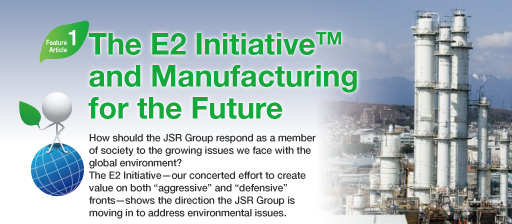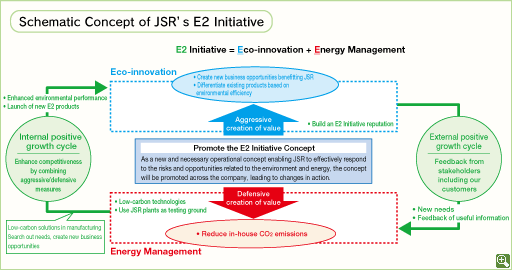In 2009, JSR launched a project that investigated possible approaches to two major goals: addressing risks related to environmental and energy issues, such as regulatory requirements for global warming mitigation, and finding ways to create new business opportunities. The E2 Initiative is the product of this endeavor. Named after the two initiatives it comprises, Eco-innovation and Energy Management, the E2 Initiative shows the outlook of JSR's Group-wide effort to create value on both aggressive fronts, such as the development of environmentally-friendly products, and defensive fronts, such as CO2 emission reductions at Group plants.
The E2 Matrix will serve as the benchmark for bringing the E2 Initiative into being. This illustrative tool shows how we added “environmental impact”—the assessment of a product's impact through lifecycle assessment (LCA), including end-use—to the set of confirmation items used in product development. In all future product development, both “environmental impact” and “economic performance” will be prerequisites, meaning that no products with a large environmental impact will be permitted even if it has great economic potential. In this way we will seek to expand our line of environmentally friendly products and instill the virtue of “environmental performance” into our corporate culture.
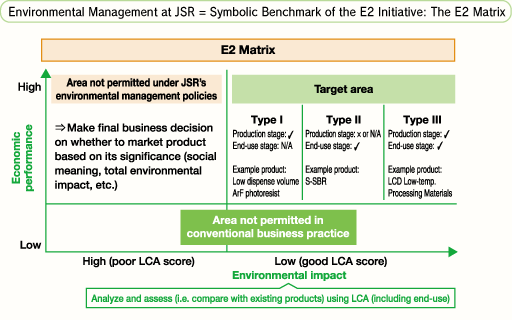
Eco-innovation is our initiative aimed at creating new business opportunities by expanding our line of environmentally friendly products and thus providing society with the value of “environmental performance.” Presented below are two important examples of this initiative: thermal management materials, and lithium-ion capacitors (LiC).
●Thermal Management Materials
One technology we are currently positioning as an “aggressive creation” area is thermal management materials. Thermal management materials are products that help to reduce energy consumption by controlling (facilitating the effective use of) heat. We are currently undertaking the development of thermal storage materials that maintain constant temperature levels and thermal barrier coating materials that insulate heat.
The thermal storage materials we are developing are paraffin, a type of organic compound, combined with a JSR proprietary polymer. These materials allow for “thermal control,” the trapping and release of heat, leading to more efficient use of energy. In addition, thermal insulation paints containing SIFCLEAR—a thermally insulating material developed by JSR—applied to a warehouse roof resulted in a 6-degree reduction in peak temperature in one test. These products make the most of JSR's expertise as the top maker of polymers.
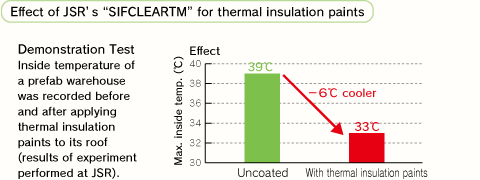
●Lithium-ion Capacitors
JSR was also quick out the gates for the development of lithium-ion capacitors (LiC), a hot technology in the race for next-generation electricity storage devices. JM Energy Corporation, a JSR Group company, beat competitors by being the first to mass-produce this technology.
In spring 2011, JM Energy launched a new laminated product with two-thirds less internal resistance than conventional products, and also began shipping samples of flat prismatic type cells and modules that dissipate heat better and are more vibration-resistant. Users have expressed great enthusiasm for these products.
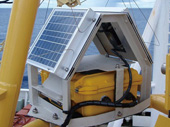
CO2 monitoring buoy equipped
with LiC (JAMSTEC)
LiCs, which can charge and discharge more quickly than batteries and have a far greater storage capacity than conventional electric double-layer capacitors, are also suitable for integrated applications with alternative energies such as solar and wind power. Applying LiCs to alternative energies, which have high output volatility, levels out this volatility, making their deployment more reliable
and efficient.
With the need for an energy shift mounting, we will continue to develop LiCs to meet a multitude of emerging needs.
In our efficiency promotion project, E-100plus, all companies in the JSR Group are deploying advanced energy-conservation technologies to reduce CO2 emissions. Monthly emissions for each division and product are now being quantified to help “visualize” progress, with recognition given to particularly successful divisions and products through a newly created award program. We are also aiming to make CO2 reduction a permanent part of business activities when starting new R&D projects or mass-scale production, for example by including the cost of CO2 emissions in their budgets.
And for newly developed products with energy-saving features, we are trying to combine such products with our “aggressive” strategy by first testing them internally and then marketing only those that demonstrated their effectiveness in reducing emissions.
- Third-Party Opinion
-
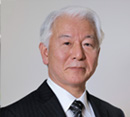
Itaru Yasui
President, National Institute of
Technology and Evaluation
Professor Emeritus,
University of TokyoUniting eco-innovation and energy management is a necessary endeavor that will also make the JSR Group a fundamentally stronger company. Due to the Great East Japan Earthquake, achieving carbon-efficient power is now a major challenge. Businesses, therefore, must determine the extent of their responsibilities while keeping a close watch on Japan's stance at COP 17 in December 2011 and trends for 2020 medium-term targets. Meanwhile, rigorous energy-saving initiatives are an effective approach in any climate. Particularly worthwhile are efforts put toward products that save energy during use. As a whole, the E2 Initiative is an ambitious initiative that we can expect to reap real and effective results.
- Response
-

Katsuya Inoue
Officer and General Manager,
Corporate Planning DepartmentProfessor Yasui's opinion was a reassuring assessment that our E2 Initiative is inherently a pursuit of two simultaneous goals: solutions to society's problems and the strengthening of our corporate competitiveness. This seems to fit in with not only our CSR philosophy, which considers societal solutions to be a corporate responsibility, but also that of Creating Shared Value (CSV), which sees such problems as an opportunity. The most important point here, I think, is that the source of value has shifted from being a dualistic question of “differentiation” or “cost,” to one where “environmental performance” is a necessary component to be balanced with one of the two. We would like to contribute to solving society's problems by closely pursuing the E2 Initiative, and by adapting quickly to the structural changes Professor Yasui mentioned are taking place after the Great East Japan Earthquake.
Return to the top of the page ▲
